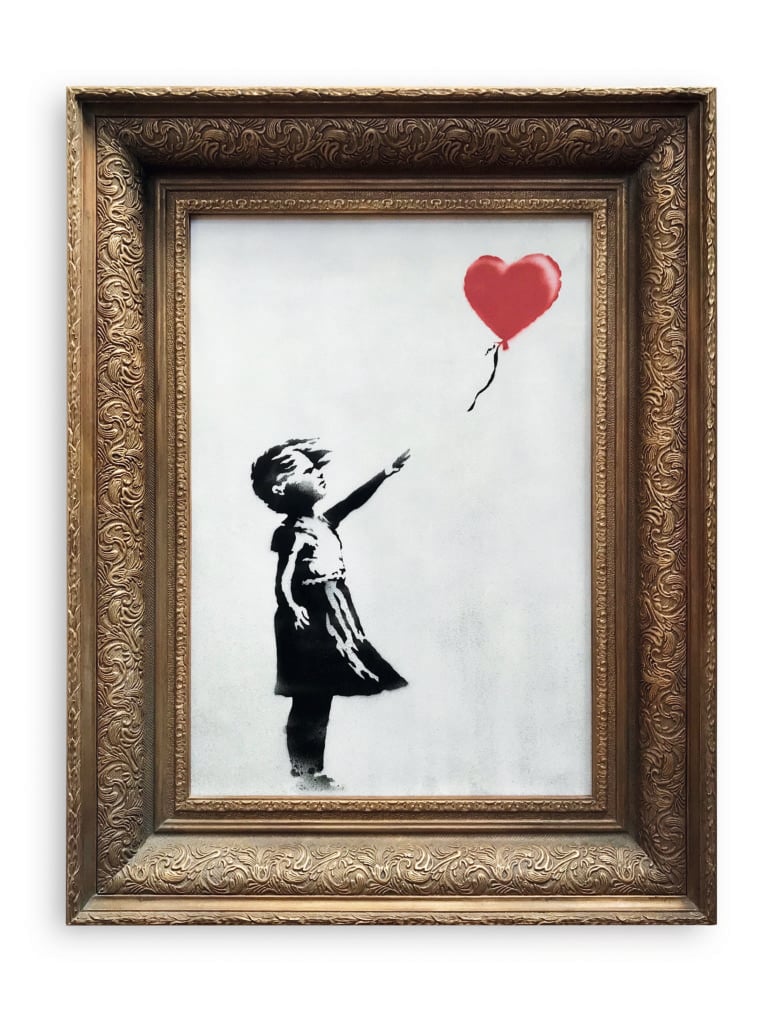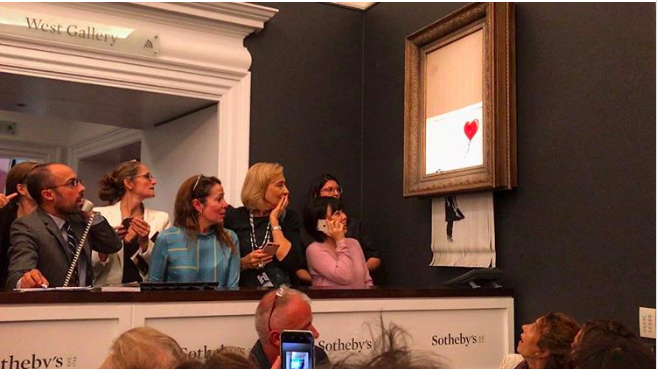Analysis
With His Viral Shredding Performance, Did Banksy Just Change the Market for Performance Art Forever?
Banksy's move actually has a lot to say about how the market—and the public's relationship to it—has changed in recent years.

Banksy's move actually has a lot to say about how the market—and the public's relationship to it—has changed in recent years.

Elizabeth Dee

By now, you have likely read about the Banksy painting that sold for $1.4 million at Sotheby’s in London last week—and then immediately shredded in the middle of the salesroom via remote-controlled device.
The event marks one of the most relevant and timely exchanges we’ve seen between the market, the artist, and the public. But you may not have considered the full significance of the act. It also arguably made the work the most expensive piece of performance art ever sold at auction.
In the process of shredding, the painting became a symbol of the increasing acceptance and integration of performance culture into the art market. And notably, it may also represent the first time performance—a medium that has proven difficult to commodify—has been associated with driving up market value.
To be sure, one could argue that this was not a performance at all—that instead, it is simply an artwork sold as a static canvas in a frame, put forward for sale like any other to an unsuspecting market.

Surprised onlookers react as Banksy’s Girl With a Balloon self-destructs at Sotheby’s.
But let’s look at it another way. Presumably, at least some people were in on the plan: the New York Times reported that Sotheby’s employees were amused, rather than shocked, by its spontaneous destruction and, most pointedly, the work was positioned as the grand finale of the sale. It seems safe to assume, then, that some Sotheby’s staff, if not the buyer and the seller, were in on the game (although the auction house has denied this).
Art is about intent, and Banksy noted on his Instagram account that he had always intended for this event to happen. He explained that he had embedded a shredder into the painting in case it was ever put up for auction. In other words, he always planned to activate it at a particular moment (an auction) with a defined audience (those attending the sale).
Like any work of performance art, Banksy’s required an audience in order for the work to be completed in real time. By combining two combustible factors—an action and the participation of the audience—the artist achieved his intention: to make a statement about value that could not have been articulated any other way.
No one yet has discussed this sale as a work of performance art. But within hours of the event, discussion on social media and in the New York Times was in part focused on the new value the act had created. “You could argue that the work is now more valuable,” Sotheby’s head of contemporary art Alex Branczik said.
In jumping from the shredding to the spike in value, however, we’ve skipped a step. We have not yet assessed how this move plays into performance art’s growing ability to change expectations. If the performance is what elevated the value, then one could argue that the performance itself pushed the work beyond the $1.4 million it achieved at the Sotheby’s evening sale. If indeed the artist, collector, and seller were in on the game, then their collaboration to create this live spectacle also helped create its value.
Having sold performance in my time as a gallerist, I think this signals a watershed moment for performance art as well as marketing strategies around live experiences. A decade ago, selling a performance was unheard of, and using brand positioning strategies to promote art was considered gauche.
Now, those reservations have evaporated. This Banksy sale is the culmination of a decade-long, largely unconscious shift. It has revealed performance art’s potential to subvert the traditional model of how art is bought and sold. In the process, it also reveals a potentially more troubling development: the growing potential of marketing, more than expertise, to establish the value of art.

Banksy’s Girl with a Balloon appeared to shred itself after selling for $1.4 million at Sotheby’s on Friday night. Courtesy of Sotheby’s.
The Banksy sale is hardly the first time that ambitious market theater has played a major role in establishing value in art. Last year, we saw the power of branding when Leonardo da Vinci’s Salvator Mundi sold at Christie’s New York for $450.3 million. Although many scholars questioned the work’s condition—and some even questioned its authenticity—the global marketing campaign Christie’s unleashed paved the way for it to achieve a record for any work of art sold at auction.
The Banksy sale also echoed a Sotheby’s event held almost exactly 10 years ago, when the auction house teamed up with Damien Hirst to sell his brand-new works fresh from the studio at the now-infamous “Beautiful Inside My Head Forever” auction, upending decades of art-market custom.
All of these examples beg the question: What happens when marketing power outweighs the original intent and context of an artist’s work so much that it calls into question the expertise at the core of the services auction houses or dealers are meant to provide?
Today, the anticipated reaction of the public informs how art is presented—at auctions, in galleries and art fairs, and in museums. It’s also an indication of how things might continue to change. With the rise of performance and event culture over the past decade, as well as the interest in experiences seen to amplify value, we are leaving big parts of the traditional playbook behind. However, if society values art more through social exchange than through exhibitions and study, it raises other questions. How—and more importantly, who—defines the value of contemporary art?
Elizabeth Dee is the co-founder of Independent Art Fairs in Brussels and New York and Elizabeth Dee Gallery, New York. Her upcoming publications include Every Future Has a Price: 30 Years After Infotainment in New York’s East Village and With the Eyes of Others: Hungarian Artists of the Sixties and Seventies published by Distributed Art Publishers.